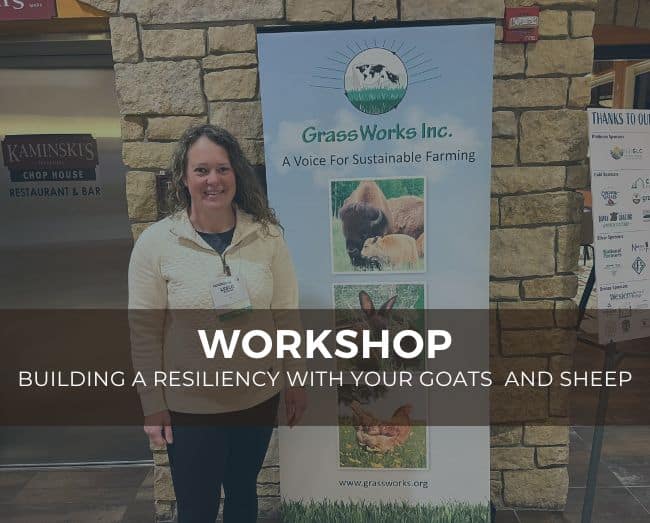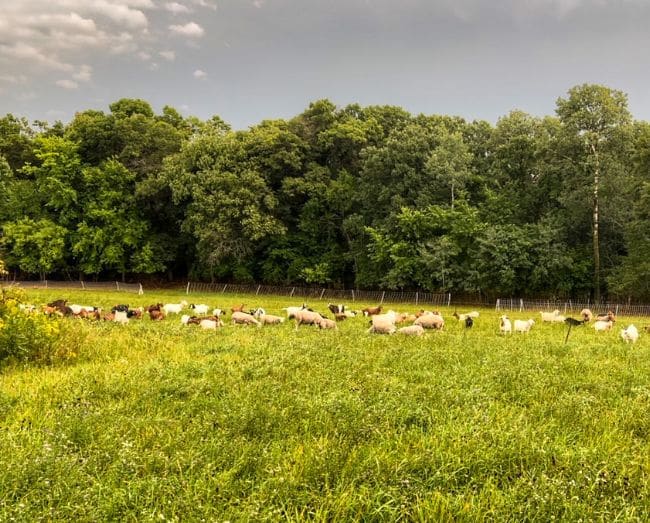Recently I lead a workshop at the GrassWorks Grazing Conference titled Managing for Resiliency with your Goats and Sheep.
If you’re not familiar with GrassWorks, it’s our state grazing organization in Wisconsin for all species of livestock – beef, poultry, hogs and small ruminants. It’s one of my favorite professional development meetings I attend annually. I always come away with new ideas to try on my farm related to grazing, land and soil management, livestock management, pasture improvement, and even direct marketing.

About the workshop
So when I was asked to lead a session for sheep and goat farmers (the only session mind you!), I was honored to do so. Knowing that it needed to reach a wide range of graziers, sheep or goat, different purposes (meat, milk, brush, etc.), and experience (aspirational to experienced), I wanted to create a presentation that most would find useful no matter their background.
I spent a bit of time thinking about what I was seeing among my peers and even experienced myself, along with also talking with several of my fellow educators on common challenges they’ve recognized within the small ruminant space as well.
The common theme was resiliency. By managing for resiliency with our goats and sheep, our farm, our business, and even in our personal life, we are better able to manage the ups and downs that come our way. Therefore, helping us better manage the stress of life and farming in a way that is healthy and allows us to keep working towards our goals as farmers.
This workshop is designed to cover a range of tools that can be used in your farm. You can pick and choose what might work for you. Adapt it to meet your needs and context of your farm and life. Not everything needs to be done at once, or at all.
References and resources mentioned in the workshop
- Slide 4: APA, (2020). Building your resilience How to Price Goat Meat
- Slide 7: Gunderson, H. (2000). Ecological resilience – in theory and application.
- Slide 13: Tennessee State University: On-Farm Performance Testing for Meat Goat Doe Herds University of Rhode Island FAMACHA certificationhttps://cylonrollingacres.myflodesk.com/i41kmi0x4s
- Slide 14: Epigenetics with Gabe Brown and Dr. Allen Williams (2021)
- Slide 18: : Hart, S. (2012). Controlling Worms in Dairy Goats: A Challenge . ACSRPC, Hart, S. (2017) How to grow worms (or not). ACSRPC.
- Slide 19: Hart, S. (2017) How to grow worms (or not). ACSRPC., Brix Level in your Forage: What does it mean? Mississippi State University (2014), Using a Brix Refractometer for Pasture and Forage Management – Grassroots Carbon
- Slide 20: Hart, S. (2017) How to grow worms (or not). ACSRPC.
- Slide 21: Rankin, M. (2018). Turning the forage world upside down – condensed tannins and small ruminants. Hay and Forage Grower, NRCS Plant Guide. Sainfoin., UW Extension Birdsfoot trefoil for grazing and harvested forage, ACSRPC: Sericea lespedeza., Utah State Benefits of Tannin-Containing Forages.
- Slide 22: Bale Grazing Podcasts, Bale Grazing Guide for Sheep/Goats
- Slide 25: Fence Training Guide
- Slide 29: Financial Document Templates (Compeer), Work with an Extension Farm Management Specialist, Extension: Developing a Farm Financial Model, Meat Suite – Cornell University
- Slide 36: Online Presence Basics for Farms
- Slide 27: Farmer Angel Network, Wisconsin Farm Center – Farmer Wellness Program

LEAVE A COMMENT
Comments